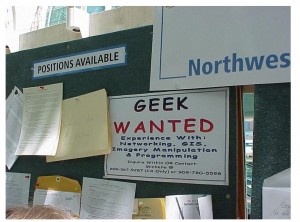Turn on suggestions
Auto-suggest helps you quickly narrow down your search results by suggesting possible matches as you type.
Cancel
- Home
- :
- All Communities
- :
- Industries
- :
- Education
- :
- Education Blog
- :
- Secretary’s Commission on Achieving Necessary Skil...
Secretary’s Commission on Achieving Necessary Skills (SCANS) Report: Ties to GIS Education
Subscribe
2237
0
06-28-2017 11:38 PM
- Subscribe to RSS Feed
- Mark as New
- Mark as Read
- Bookmark
- Subscribe
- Printer Friendly Page
06-28-2017
11:38 PM
Several documents over the past 20 years have played key roles in shaping GIS in education and remain excellent resources for making the case why the work of the GIS education community is necessary. One of the first and one of my personal favorites was the U.S. Secretary of Labor’s Commission on Achieving Necessary Skills (SCANS) report. This report identified that the “task of learning is the real work of today, whether at school, in the university, on the job…” (1991, page 5). SCANS then stated (1992) that core subjects must be taught and learned “in context.” “In context” means learning content while solving realistic problems. Students are learning software, cartography, and GIS skills while using GIS to study world biomes, a regional watershed, or local community traffic, but they are also learning content.
SCANS identified five competencies important for future work success: Resources, interpersonal, information, systems, and technology. “Resources” include identifying, organizing, planning, and allocating, while “interpersonal” means working with others in a diverse team. “Information” includes interpreting and communicating, and “systems” include understanding complex interrelationships. “Technology” is identified as working with, selecting, and applying technologies, and this too is fundamental to the work done with GIS. When we teach with GIS or about GIS, we typically use multimedia software and hardware, desktop and cloud tasks and data, smartphones and GPS, field probes and sensors, different operating systems, databases, data in many formats, spreadsheets, and scanners, just to name a few technologies, all in an applied fashion.

The SCANS report can be effectively used as a means of communicating why it is vital that GIS education must continue. Moreover, it can help justify the case why GIS in education must increase in the disciplines where it is already established and spread to those that are not fully engaging with it. The GIS education community must make clear and well known the ties between our work and the SCANS report. Given the escalation in the importance of such critical issues as food, natural hazards, population, biodiversity, water, and energy in our world, spatial analysis through GIS is even more relevant to education than when these reports were written 20 years ago.
How might you use the SCANS report to communicate the importance of your work in GIS education and gain support for that work?
BibliographyU.S. Department of Labor Secretary’s Commission on Achieving Necessary Skills. 1991. What Work Requires of Schools. Washington DC: U.S. Department of Labor.U.S. Department of Labor Secretary’s Commission on Achieving Necessary Skills. 1992. Learning a Living: A Blueprint for High Performance. Washington DC: U.S. Department of Labor.
- Joseph Kerski, Esri Education Manager
You must be a registered user to add a comment. If you've already registered, sign in. Otherwise, register and sign in.
About the Author
I believe that spatial thinking can transform education and society through the application of Geographic Information Systems for instruction, research, administration, and policy.
I hold 3 degrees in Geography, have served at NOAA, the US Census Bureau, and USGS as a cartographer and geographer, and teach a variety of F2F (Face to Face) (including T3G) and online courses. I have authored a variety of books and textbooks about the environment, STEM, GIS, and education. These include "Interpreting Our World", "Essentials of the Environment", "Tribal GIS", "The GIS Guide to Public Domain Data", "International Perspectives on Teaching and Learning with GIS In Secondary Education", "Spatial Mathematics" and others. I write for 2 blogs, 2 monthly podcasts, and a variety of journals, and have created over 6,500 videos on my Our Earth YouTube channel.
Yet, as time passes, the more I realize my own limitations and that this is a lifelong learning endeavor: Thus I actively seek mentors and collaborators.
Labels
-
Administration
65 -
Announcements
68 -
Career & Tech Ed
1 -
Curriculum-Learning Resources
233 -
Education Facilities
24 -
Events
60 -
GeoInquiries
1 -
Higher Education
566 -
Informal Education
273 -
Licensing Best Practices
75 -
National Geographic MapMaker
27 -
Pedagogy and Education Theory
209 -
Schools (K - 12)
282 -
Schools (K-12)
240 -
Spatial data
30 -
STEM
3 -
Students - Higher Education
240 -
Students - K-12 Schools
116 -
Success Stories
33 -
TeacherDesk
1 -
Tech Tips
101
- « Previous
- Next »